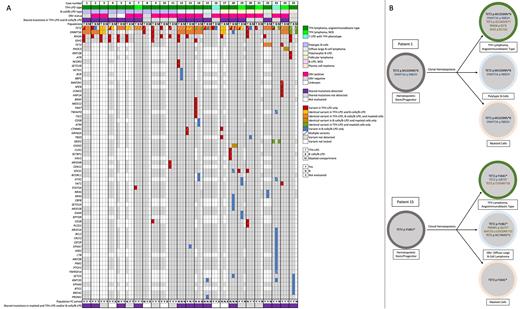Introduction:
Patients with follicular helper T-cell lymphomas/lymphoproliferative disorders (TFH-LPDs) commonly develop B-cell lymphoproliferative disorders and lymphomas (B-LPDs), but the pathophysiology is incompletely understood. TFH-LPDs often arise from TET2-/ DNMT3A-mutated clonal hematopoiesis (CH). Here we show TET2/ DNMT3A mutations are commonly shared by polytypic B-cells (PBCs), B-LPDs, and TFH-LPDs, with the latter two often carrying additional unique mutations.
Methods:
Pathology database search at Memorial Sloan Kettering identified patients with TFH-LPDs and PBCs or B-LPDs available for genotyping. If available, myeloid cells were also genotyped. PBCs lacked aberrancies by morphology and flow cytometry (FC) immunophenotyping (including polytypic light chain expression). TFH-LPDs and B-LPDs were defined using International Consensus Classification criteria. Genotyping assays included targeted next-generation sequencing (NGS) with (n=13) or without (n=8; cases 1, 4, 9, 10, 15, 16, 17, 22) a matched germline control and droplet digital PCR (n=4; cases 2, 3, 5, 6). Genotyping was performed on bulk samples or FC-sorted cells, including T-, B-, and myeloid as available. In bulk samples, mutations with allele frequencies (VAFs) >2x the percentage of neoplastic T- and myeloid cells combined in B-LPD samples and of neoplastic T- and total B-cells in bulk blood (PB)/bone marrow (BM) samples were considered present in B-LPD or myeloid compartments, respectively. A >2% VAF cutoff was utilized. EBV status was assessed using EBER in situ hybridization on tissues, serum EBV DNA by quantitative PCR, and/or evaluation of off target EBV reads by NGS. Statistical analyses utilized Mann-Whitney U tests.
Results:
In total, 25 patients (10 female, 15 male; median age 70 [range 38-82] years) with TFH-LPDs (19 TFH lymphoma, angioimmunoblastic type, 4 TFH lymphoma, NOS, 2 T-LPD with TFH phenotype [defined by morphologically and/or immunophenotypically atypical T-cells with both TFH-like phenotypes and genomic alterations that did not fulfill morphologic criteria for diagnosis of lymphoma]) were identified. The TFH-LPDs harbored TET2 (25/25, 100%), DNMT3A (12/25, 48%), RHOA p.G17 (15/25, 60%), and IDH2 p.R172 (9/25, 36%) mutations (Figure 1A).
PBCs from 11 patients were evaluated (7 EBV+, 3 EBV-, 1 EBV unknown; 5 from lymph node, 4 PB, 2 BM). PBCs from 7/11 (64%) shared identical TET2 (n=6; median VAF 0.11 [range 0.02 - 0.27]) and/or DNMT3A (n=3; median VAF 0.05 [range 0.03-0.49]) mutations with corresponding TFH-LPDs. PBCs in 1 patient harbored a unique mutation ( TET2). Four of 8 (50%) patients in which myeloid cells were assessed harbored identical TET2 and/or DNMT3A mutations in the myeloid, PBC, and TFH-LPD compartments.
B-LPDs were evaluated from 14 patients (5 diffuse large B-cell lymphoma, 5 polymorphic B-LPD, 2 follicular lymphoma, 1 B-LPD, NOS, 1 plasma cell myeloma; 11 EBV+, 3 EBV-; 9 from tissue, 4 PB, 1 BM). Polymorphic B-LPDs showed atypical polymorphic morphology and an abnormal B-cell immunophenotype by FC and/or a clonal IgH gene rearrangement. The B-LPD, NOS showed an abnormal CD5-/CD10- immunophenotype with light chain restriction by FC without available tissue for morphologic evaluation. Nine of 14 (64%) B-LPDs shared identical mutations with corresponding TFH-LPDs ( TET2 [n=9; median VAF 0.42 (range 0.10- 0.56)], DNMT3A [n=5; median VAF 0.27 (range 0.05-0.50)], TET3 [n=1; VAF 0.32]). Myeloid compartments in 9/12 (75%) patients shared identical TET2 and/or DNMT3A mutations with B- and/or T-LPDs. B-LPDs more commonly harbored additional mutations absent in corresponding TFH-LPDs than PBCs (12/14 [86%] vs 1/8 [13%] evaluated by NGS; p=0.001). Unique mutations in B-LPDs involved epigenetic/transcriptional regulation (n=14, e.g. TET2, KMT2D, SETD5), signaling pathways (n=22, e.g. DTX1, KRAS, EPHA5), and DNA damage response (n=3, e.g. ATM, CHEK2, BRCA2). Incidences of shared and unique mutations did not significantly differ among EBV+ and EBV- cases.
Conclusions:
Both PBCs and B-LPDs in TFH-LPD patients are commonly EBV+ and share TET2/ DNMT3A mutations with TFH-LPDs, consistent with common origin from CH. B-LPDs more often harbor additional unique mutations than PBCs. Thus, CH mutations and EBV activation in B-cells may predispose TFH-LPD patients to B-LPDs, which may develop with additional private genomic aberrations aiding transformation (Figure 1B).
Disclosures
Lewis:United States Drug Testing Laboratories: Consultancy, Membership on an entity's Board of Directors or advisory committees. Roshal:Physicians' Education Resource: Other: Provision of services; Celgene: Other: Provision of services; Auron Therapeutics: Other: Ownership/Equity interests; Provision of services; NGM: Other: Funding; Roche: Other: Funding; Beat AML: Other: Funding. Baik:Pauling.AI: Current Employment. Moskowitz:Merck: Honoraria, Research Funding; ADC Therapeutics: Research Funding; Bristol-Myers Squibb: Research Funding; Beigene: Research Funding; Incyte: Research Funding; Seattle Genetics: Honoraria, Research Funding. Horwitz:Takeda: Consultancy, Research Funding; Tubulis: Consultancy; Crispr Therapeutics: Research Funding; Millenium: Research Funding; Seattle Genetics: Research Funding; Verastem/SecuraBio: Research Funding; Trillium Therapeutics: Consultancy, Research Funding; Affimed: Research Funding; Celgene: Research Funding; Daiichi Sankyo: Consultancy, Research Funding; Kyowa Hakko Kirin: Consultancy, Research Funding; ONO Pharmaceuticals: Consultancy; SecuraBio: Consultancy; Shoreline Biosciences, Inc.: Consultancy; ADC Therapeutics: Research Funding; Yingli Pharma Limited: Consultancy; Cimieo Therapeutics: Consultancy; Abcuro Inc.: Consultancy; Auxilius Pharma: Consultancy. Dogan:Incyte: Consultancy; Peer View: Honoraria; Loxo: Consultancy; EUSA Pharma: Consultancy; Physicians' Education Resource: Consultancy, Honoraria; Seattle Genetics: Consultancy; Takeda: Other: Research Funding; Roche: Other: Research Funding.


This feature is available to Subscribers Only
Sign In or Create an Account Close Modal